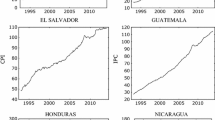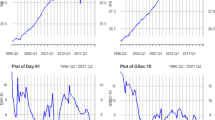Abstract
This paper analyses the relation between money and inflation in Germany in a cost-push/demand-pull model of an open small economy by means of cointegration methods. The full-information-maximum-likelihood method of Johansen as well as structural methods are applied to datasubsets and the full data set. The focus of the paper is on tests for overidentifying restrictions and for weak and strong exogeneity within these data sets. The result of the paper is that the money stock, the price level and gross national product are endogenous whereas the interest rate and the real import price are both weakly and strongly exogenous. By means of the price cointegration relation we illustrate how monetary targeting should react to imported inflation.
Similar content being viewed by others
References
Banerjee A, Dolado JJ, Mestre R (1992) On some simple tests for cointegration: The cost of simplicity. Discussion Paper, Aarhus University
Bewley RA (1979) The direct estimation of the equilibrium response in a linear model. Economic Letters 3:357–361
Boswijk HP (1991) The LM-Test for weak exogeneity in error correction models. University of Amsterdam, Report AE 13/91
Boswijk HP (1995) Efficient inference on cointegration parameters in structural error correction models. Journal of Econometrics 69:133–158
Deutsche Bundesbank (1994) The monetary policy of the Bundesbank. Frankfurt
Dolado JJ, Lütkepohl H (1994) Making Wald tests work for cointegrated VAR systems. Humboldt University Berlin, Discussion Paper 44
Dieckmann O, Westphal U (1995) SYSIFO Dr. Siegel & Partner, Hamburg
Dickey DA, Fuller WA (1979) Distribution of the estimators for autoregressive time series with a unit root. Journal of the American Statistical Association 74:427–431
Engle RF, Granger CWJ (1987) Cointegration and error correction: Representation, estimation, and testing. Econometrica. 55:251–276
Franz W, Gordon RJ (1993) German and American wage and price dynamics: Differences and common themes, European economic review 37:719–762
Hallman JJ, Porter RD, Small DH (1991) Is the price level tied to the M2 monetary aggregate in the long run. The American Economic Review 81:841–858
Hansen G (1994) Cointegration and the monetary model of the exchange rate. in: Kähler H, Kugler P (Ed.) Econometric modelling of financial markets. Physica: 47–63
Hansen G (1993) Quantitative Wirtschaftsforschung. Vahlen
Hansen G, Kim J-R (1995) Stability of German money demand. Tests of the cointegration relation. Weltwirtschaftliches Archiv 131:286–301
Hendry DF, Mizon GE (1993) Evaluation of dynamic econometric models by encompassing the VAR. Chapter 18. in: Phillips PCB (ed.) Models, methods and applications of econometrics, essays in honor of Rex Bergstrom. Oxford: 272–300
Issing O, Tödter KH (1994) Geldmenge und Preise im vereinigten Deutschland. Beitrag zur Sitzung des Ausschusses fur Geldtheorie und Geldpolitik im Verein für Sozialpolitik vom 25. bis 26. 2. 94, Frankfurt/M
Johansen S (1988) Statistical analysis of cointegration vectors. Journal of Economic Dynamics and Control 12:231–254
Johansen S (1992) Testing for weak exogeneity and the order of cointegration in the UK money demand data. Journal of Policy Modeling 14:313–334
Johansen S, Juselius K (1990) Maximum Likelihood estimation and inference on cointegration —With applications to the demand for money. Oxford Bulletin of Economics and Statistics 52:169–210
Johansen S, Juselius K (1992) Structural tests in a multivariate cointegration analysis of the PPP and the UIP for UK. Journal of Econometrics 53:211–244
Johansen S, Juselius K (1994) Identification of the long-run and the short-run structure: An application to the ISLM model. Journal of Econometrics 63:7–36
Kugler P, Lenz C (1993) Multivariate cointegration analysis and the long run reality of PPP. The Review of Economics and Statistics 75:180–187
MacDonald R (1993) Long run purchasing power parity: Is it for real?. Review of Economics and Statistics 75:690–695
Mizon GE (1994) Progressive modelling of macroeconomic time series: The LSE methodology. Discussion Paper, Economics Department, European University Institute, Florence, Italy
Parikh A (1991) Modelling the exchange rate behavior of Yen and Deutsche Mark against the Dollar. Weltwirtschaftliches Archiv 127:472–498
Phillips PCB, Hansen BE (1990) Statistical inference in instrumental variables regression with I(1) processes. Review of Economic Studies 57:99–125
Scarth WM (1988) Macroeconomics. An introduction to advanced methods. Toronto
Serletis A (1994) Maximum Likelihood cointegration tests of purchasing power parity: Evidence from 17 OECD countries. Weltwirtschaftliches Archiv 130:476–493
Tietmeyer H (1994) Role and instruments of monetary policy. Kieler Vorträge, Neue Folge, 124, Institut für Weltwirtschaft an der Christian-Albrechts-Universität Kiel
Toda HY, Phillips PCB (1994) Vector autoregression and causality: A theoretical overview and simulation study. Econometric Reviews 13:259–285
Tödter KH, Reimers HE (1994) P-Star as a link between money and prices in Germany. Welt-wirtschaftliches Archiv 130:273–289
Wickens MR, Breusch TS (1988) Dynamic specification, the long-run and the estimation of transformed regression models. The Economic Journal 98:189–205
Author information
Authors and Affiliations
Additional information
We are grateful to Volker Clausen and two anonymous referees for helpful comments. Financial Support of the North-German Central Bank, Hamburg is gratefully acknowledged.
Rights and permissions
About this article
Cite this article
Hansen, G., Kim, JR. Money and inflation in Germany: A cointegration analysis. Empirical Economics 21, 601–616 (1996). https://doi.org/10.1007/BF01180704
Received:
Revised:
Issue Date:
DOI: https://doi.org/10.1007/BF01180704




